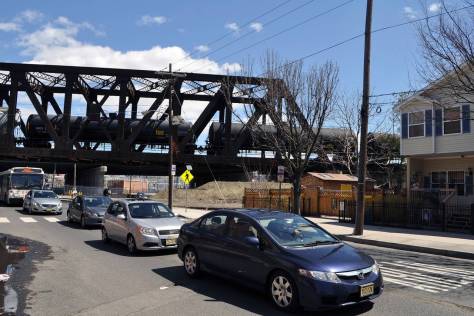Repost from the Pottstown Mercury
LETTERS: Safety of ‘bomb trains’ is public health priority
By Dr. Lewis Cuthbert, 04/25/15, 2:00 AM EDTThe Mercury article of Feb. 23, “We just have to hope that nothing happens” has profound implications to everyone in the Greater Philadelphia Region. We applaud the March 1 Mercury editorial conclusion, “Clearly, hope is not enough to maintain safety…”
So-called “bomb trains” containing up to 3 million gallons of explosive, flammable, hazardous crude oil travel right through Pottstown and the Limerick Nuclear Plant Site. A derailment, explosion and days-long fire ball near Limerick’s reactors and deadly fuel pools could trigger simultaneous meltdowns with catastrophic radioactive releases. Millions of Greater Philadelphia Region residents could lose everything forever.
Days of thick black smoke from a crude oil fire could be devastating. Even Occidental Chemical’s large vinyl chloride accidents (seven-tenths of a mile from Limerick) caused problems at Limerick, according to employees, some of whom are very worried about crude oil train derailments.
Risks are increasing. Emergency responders are smart to be concerned. They shouldn’t be expected to be on the front lines of such devastating uncontrollable disasters.
Train derailment disasters should be anticipated. Sixty-five tank cars bound for Philadelphia had loose, leaking, or missing safety components to prevent flammable, hazardous contents from escaping (Hazmat report – last two years). A fuel-oil train already derailed a few miles from Philadelphia.
Heat from the rupture and ignition of one 30,000-gallon car can set off a chain reaction, causing other cars to explode, releasing a days-long fireball. Basically, responders must let it burn out.
Over 100 railcars, estimated to hold three million gallons, regularly sit on tracks from the Dollar General in Stowe to Montgomery County Community College.
ProPublica data from the federal Pipeline and Hazardous Materials Safety Administration (2011-2014) shows incidents in over 250 municipalities. The worst of eight major crude oil train accidents include:
- A train derailment and explosion killed 47 and destroyed 30 buildings in Quebec.
- 2,300 residents were evacuated in North Dakota. The fireball was observed states away.
Safer trains aren’t the answer. A new safer-design derailed February 2015 in West Virginia, despite adhering to the speed limit. Hundreds of families had to flee their homes in frigid weather. Burning continued for days. Drinking water and electricity were lost. Leaking crude oil poisoned the water supply. Fireballs erupted from crumbled tank cars, underscoring volatility of crude oil’s propane, butane, etc.
Safe evacuation from our densely populated region is an illusion. Limerick Nuclear Plant’s evacuation plan is unworkable and unrealistic, not robust as claimed by a health official. Just consider work hour traffic combined with deteriorated roads and bridges. We encourage officials to visit www.acereport.org to view ACE’s 2012 video-blog series on the reality of Limerick’s evacuation plan. For a graphic presentation call (610) 326-2387.
Who pays to deal with irreversible devastation from train derailments and meltdowns? Clearly, not the oil industry, nuclear industry, railroad or government. We’d be on our own, despite:
- Long-term ecological damage that would leave ghost towns that can’t be cleaned up safely.
- Risking the vital drinking water resource for almost two million people (Pottstown to Philadelphia).
- Millions of people losing their homes, businesses and health.
Richard Lengel, Pottstown’s Fire Chief, admitted, “If something catastrophic happens, there’s no municipality along the railroad that can handle it, the volume [crude oil] is too great. We just have to hope that nothing happens, honestly.”
Hope is no solution! Neither is denying the reality of our unacceptable devastating risks.
The catastrophic disasters we face can, and must, be prevented with foresight and political will to face the facts and take action. Enough of corporate profits jeopardizing public safety.
Wake up! Speak up! Tell local, state and federal elected officials to stop this insanity!
Say no to dangerous crude oil trains traveling through our communities and the Limerick site.
Say no to continued Limerick Nuclear Plant operations to avoid meltdowns that can be triggered by cyber/terrorist attacks, embrittled/cracking reactors, earthquakes and now oil-train explosions/fires.
— Dr. Lewis Cuthbert
ACE President





You must be logged in to post a comment.